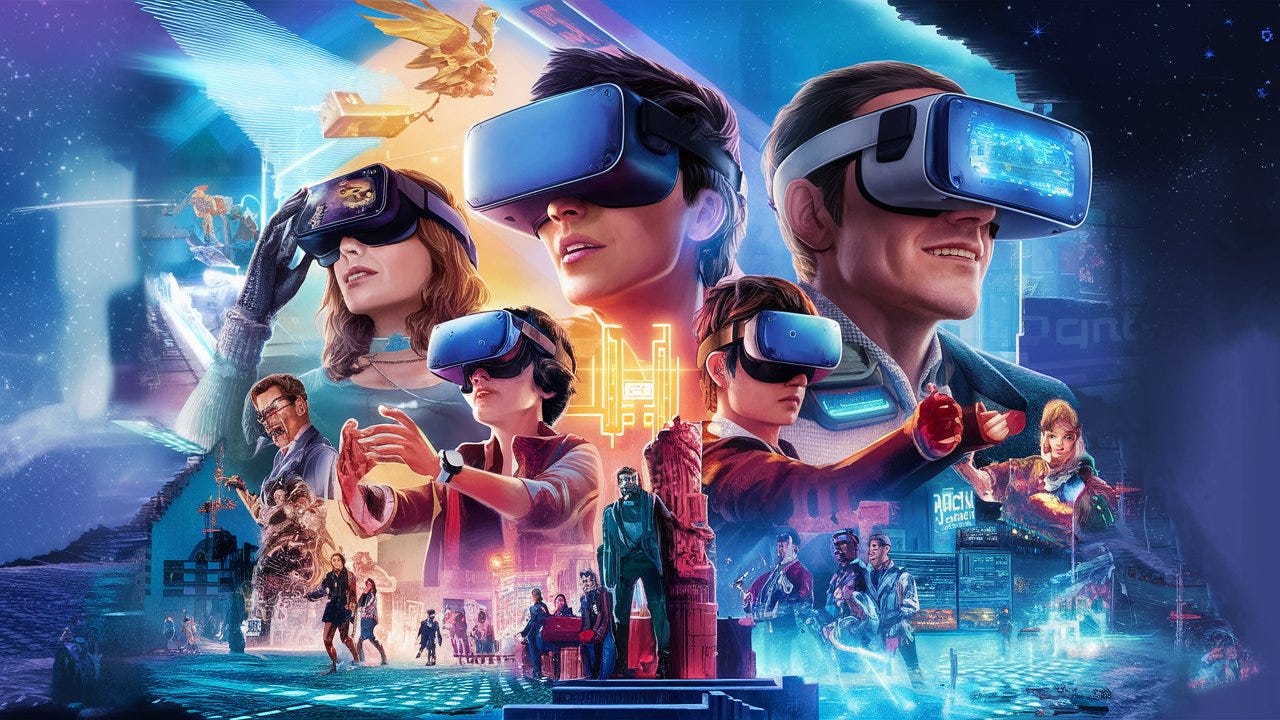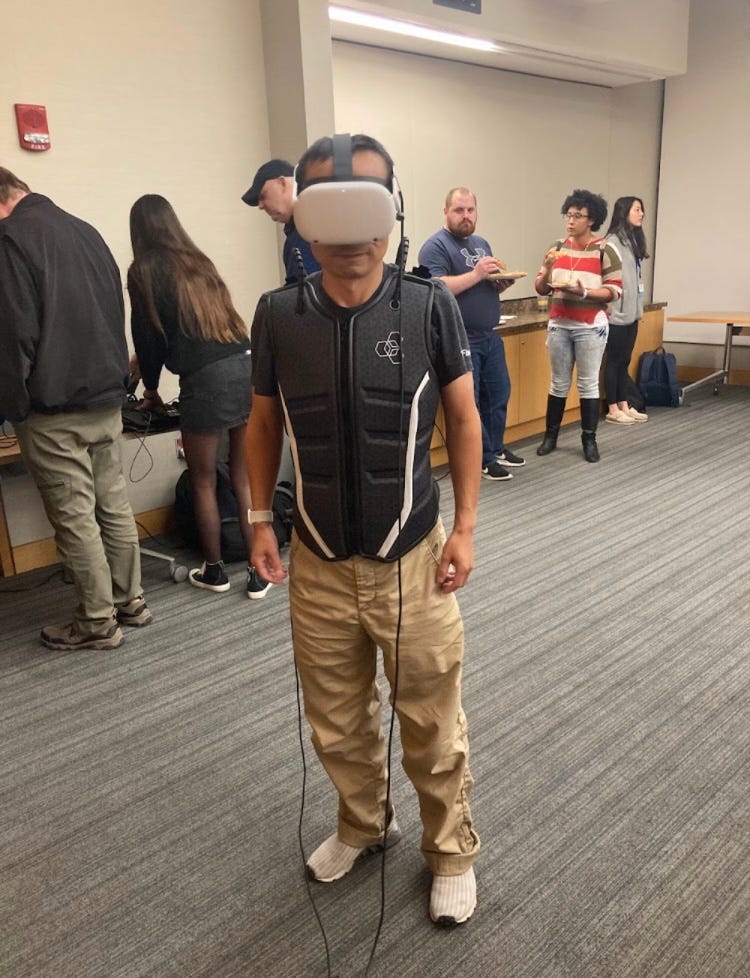Boston VR Newsletter - August 2024 Edition
Monthly Socials, Crafter's Corners, Project Spotlight , and More...
Monthly Socials!
The organizers and volunteers of Boston VR are continuing our monthly socials at TimeOut Market.
The next social is on September 9th at 7 pm.
Click here to RSVP!
Boston VR Blender August Meetup!
RSVP for the next session on August 24th!
Due to unforeseen circumstances, cancelled until further notice
It’s hosted by the awesome John Gagan, an experienced web developer, and artist, who has seven years of experience with Blender, four of which he spent as the head of the Boston Blender Group. He has degrees in Art and Computer Science and has combined these interests by studying Unity and Blender.
This dev jam is your chance to learn about Blender or sharpen your skills!
For more info, click here to RSVP for the event!
Details:
Watertown Public Library, Room: Lucia Mastrangelo Meeting Room
*Bring your laptops and preferably a three-button mouse, as this is a hands-on demo.
Description: Learn how to model and animate a train! At the August meetup, Erik Nelson will show us how to build a small landscape in Blender, containing an animated model train and render an animation from the point of view of a person on the train, as it goes around the track.
Erik Nelson is a six-year veteran in 3D modeling and animation.
To view the finished train animation:
Crafter’s Corner – What is running that VR headset anyway?
Welcome to Crafter’s Corner, the section of the VR Newsletter where we will be discussing how to build your own content for VR devices. Every month, we’ll be going through some details of how VR systems work and the hardware and software underneath, with an eye towards how anyone can build content for VR with a little knowledge and practice.
This month we’ll kick us off by talking about the hardware that is running underneath the most common types of headsets you can build for using a home computer. There are currently three major categories of home headset in 2024: the Quest line from Oculus, now owned by Meta, the Vision Pro by Apple, and a number of headsets that can connect to PC games, such as Sony’s PSVR2 or Vive’s headsets, collectively called “PCVR” headsets.
An important distinction between PCVR headsets and the Quest and Vision Pro is that PCVR headsets are acting as monitors and controllers for the software but they do not run the software itself. The software runs on the computer that the PCVR is connected to. So, like any graphical-intensive software for a PC, the software for a PCVR will be dependent on how powerful a graphics card is in the PC.
The Apple Vision Pro has its own powerful graphics card running in it and does not require an external computer to run its software. Since it is an Apple product, just like a Mac, iPhone, or iPad, building software for the Vision Pro requires a Macintosh computer to build. One big difference between building for the Apple Vision Pro and for PCVR is that you know anyone running your project will have a powerful graphics card running, giving you the ability to build high quality visuals for your project without needing to worry about the headset being unable to keep up. (Side note: this is why the Apple Vision Pro has a battery tethered to the headset. Those GPUs require a lot of electricity!)
The Quest, like the Apple Vision Pro, is a standalone device that does not require an external computer to run its software. Unlike the Apple Vision Pro, the Quest is built on Android mobile architecture and does not have a huge battery tied to it. For these reasons, the Quest is a less powerful system to run software than any of the other choices. This is why Quest users are typically surprised to find that software for the Quest looks simpler than software for other VR systems. The Quest simply doesn’t have the graphics or battery power required to run more advanced graphics capabilities.
Now that we’ve covered the different hardware out there, next month we’ll go into what tools people need to be able to build software to run on these devices. See you then!
Justin is a long-time software engineer who specializes in cloud and VR development. He can be reached at:
https://archmag.us
Project Spotlight: “The Virtual Egyptian Temple”
Jeffrey Jacobson was involved in Virtual Reality for education with a focus on cultural history and heritage from 1992 to 2013. It was part of his very long graduate student career and the focus of his educational nonprofit, PublicVR. PublicVR was mothballed in 2014, but later merged with BostonVR in 2015. That’s how BostonVR is a 501c3 nonprofit, because our work to educate the public on VR is part of the original PublicVR charter. A good marriage.
At the center of every flourishing ancient Egyptian community, there was a sacred temple, the House of the Divinity. This Establishment (Sacred Corporation) was a model for the Egyptian world, encompassing religion, government, daily life, and harmony between heaven and earth. The Virtual Egyptian Temple does not represent any particular site, but embodies the key elements of a New Kingdom temple. It is built from respected sources and intended to for all ages’ curricula in history, archeology, religion, and culture. Created in Virtual Reality in 1993 (VR Tookit), showed at the Guggenheim Soho the next year. Rebuilt in 1995 (VRML), Rebuilt in 2004 (Unreal Tournament), rebuilt in 2014 (Unity)
Would you like to spotlight your VR project to inspire creativity in our community? Email Chris at chris@bostonvr.org with a short description of your project and why it should be included in the newsletter.
Book of the Month:
From the leading theorist of the Metaverse comes the eagerly anticipated, revised and updated account of the next internet: what the Metaverse is, what it will take to build it, and what it means for all of us.
A Hudson Booksellers, Amazon, Guardian, Financial Times, Economist, and ByteDance Toutiao Best Book of the Year
In this substantially revised and updated edition of his internationally best-selling book, pioneering theorist and entrepreneur Matthew Ball goes beyond the hype cycle to present a definitive account of the future of the internet. The Metaverse, according to Ball’s industry-shaping definition, is a persistent and interconnected network of 3D virtual worlds that will eventually serve as the gateway to most online experiences and underpin much of the physical world.
From the history of video games and virtual reality to “proto-metaverses” such as Second Life, Fortnite, and Roblox to Generative AI and the groundbreaking films and television series of the Walt Disney Company, Ball points out that the Metaverse is already emerging around us (and doesn’t require a headset). Still, there are many breakthroughs required to fully realize the Metaverse, and he describes each in approachable but expert detail. Ball also lays out how governmental policy, the philosophy of Big Tech leaders, artificial general intelligence, economics, and human rights will shape the development of the Metaverse.
Stay tuned for our next newsletter for more updates, highlights, and community stories. Let's keep exploring the infinite possibilities of extended reality together!
Boston VR is committed to fostering a welcoming and innovative community for XR enthusiasts and professionals.
Whether you're a developer, creator, researcher, or just plain curious, we're excited to explore the future of XR with you.
For more detailed discussions and to share your thoughts or experiences, don't hesitate to join us at our next meetup or reach out through our community channels.
See you in the virtual world!
Join the Boston VR Slack
To join, click here
Interested in Volunteering with Boston VR?
Email Casey We need help with marketing, event planning, dev jams, sponsorship, and more!
Thank you to our Premium Sponsor, AMXRA!
AMXRA is the premier medical society advancing the science and practice of medical extended reality, https://amxra.org/.
AMXRA has generously committed to being a premium sponsor for Boston VR over the coming years. We are immensely grateful for their support and partnership in exploring the forefront of XR technology.















